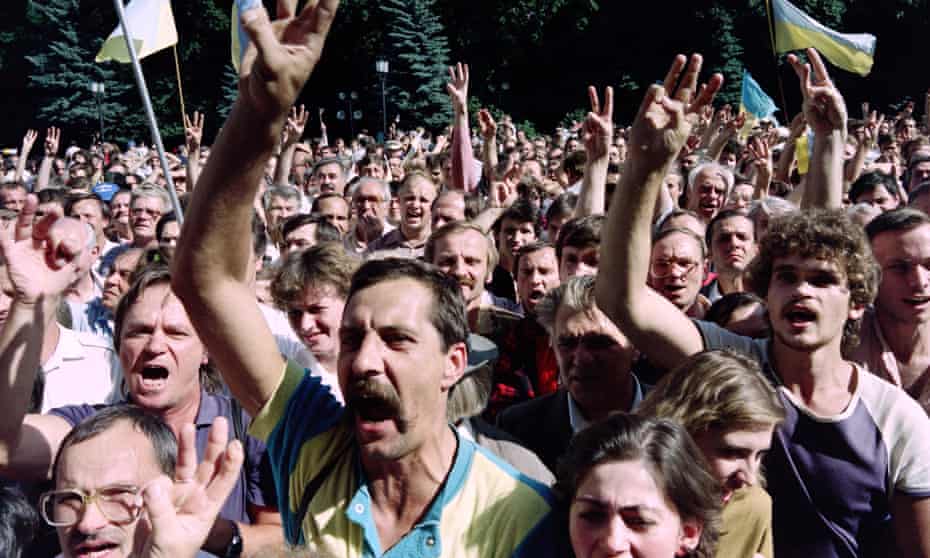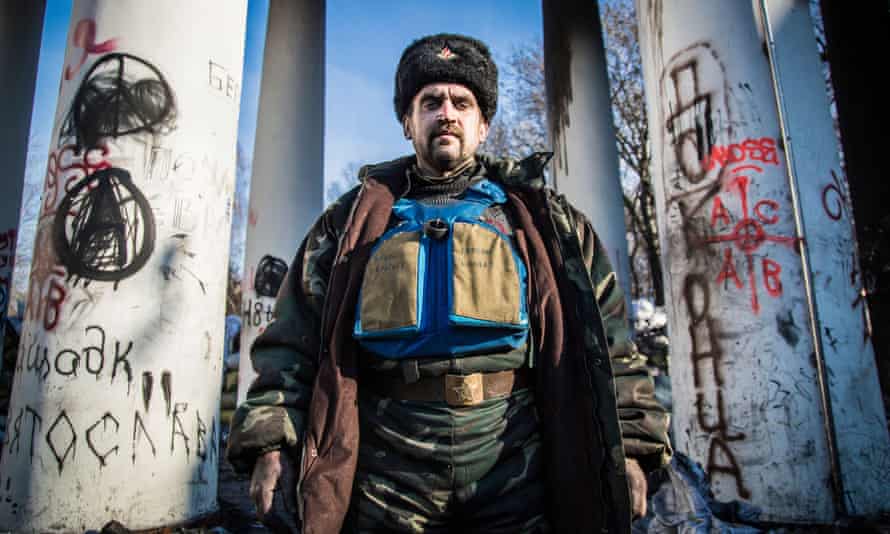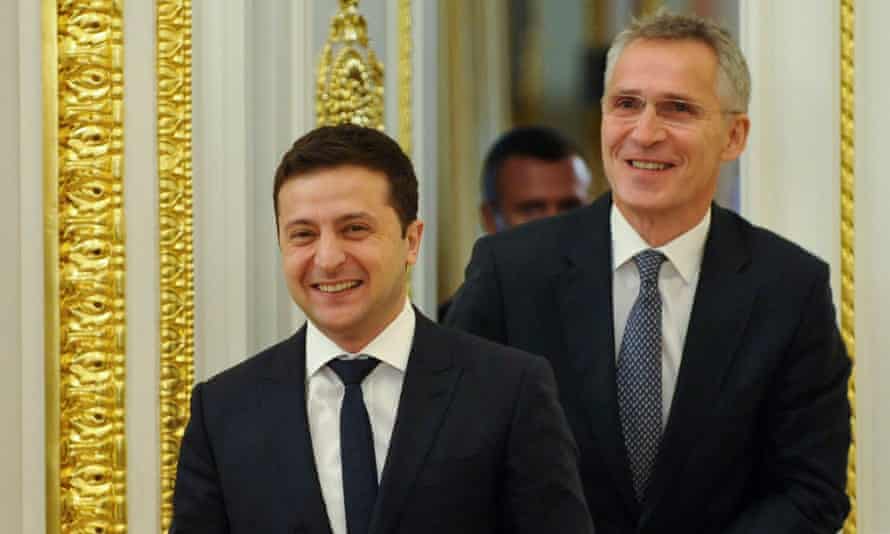The Guardian
The power of the new Ukraine
James Meek – March 20 2022

How the country has transformed from a Russian client state to a would-be EU nation where liberals and nationalists have found common cause
Ukraine has been an independent country for more than half Vladimir Putin’s adult life (he turns 70 this year). It’s been a free republic for more than 30 years, long enough for the first generation of Ukrainians born since independence to have school-age children of their own. It’s had seven different leaders, all of them still alive.
It would be sentimental – and patronizing – to talk about a country having “grown up”. But 30 years is long enough for countries to change, for better or for worse; long enough for countries to have eras. Ukraine was well into its second era, its European era, when Putin invaded last month. Putin never accepted the right of post-Soviet Ukraine to exist in independent Ukraine’s first era. In terms of understanding the country, that’s the period he’s stuck in; Putin doesn’t acknowledge that a second era began.
The west shares many of the Kremlin’s misapprehensions about Ukraine. We are still too ready to see the country through the cliche of a “nationalist, Ukrainian-speaking” west and a “Russia-friendly, Russian-speaking” south and east. Or, more crudely and colourfully, neo-communist miners in the east, neo-Nazis in the west. Of course it was never that simple, even in post-Soviet Ukraine. But European-era Ukraine, which emerged in 2014, overturned its own political fundamentals. Faced with an existential struggle against a powerful, ruthless neighbour, Russia, where nationalism now serves autocracy, an emergent class of Ukrainian liberals made common cause with Ukrainian nationalists. It’s been an uncomfortable alliance but it has kept the country together. As Ukraine defends itself against Putin’s terror campaign, mutually estranged liberals and nationalists in other countries – the US, England, France – would do well to watch.
To talk about “European Ukraine” isn’t to describe an achieved state but a state of hope: hope of membership in the European Union – more meaningful to Ukraine, at least until Russia attacked, than membership of Nato.

Advertisement
Ukraine’s hope of Europe had its material side, a hope of grants, jobs and trade. Since the “revolution of dignity” – also known as “Maidan” – in 2014, trade with the EU soared while trade with Russia plunged. More than a million Ukrainians went to work, legally or otherwise, in the EU. Since Russia invaded Ukraine on 24 February, much has been made in Britain of the EU’s openness to Ukrainian refugees compared with the barriers put up by London. But it’s a depressing reflection of how mainstream anti-immigrant assumptions have become in the UK that virtually no one in Britain is aware the EU gave Ukrainians visa-free access years ago, as a reward for their country’s sacrifices in Europe’s name. Since 2017, as a result of that and of Brexit, Ukrainians have levelled up and Britons levelled down to identical rights of EU entry: 90 days’ stay without a visa.
Beyond the material hopes of European-era Ukraine, there is the prospect, less tangible and more powerful, of an alternative form of nationhood. Rather than the archaic, romantic, racial mystifications of old Ukrainian nationalism, or Putin’s neo-imperial vision of Ukraine pulverised and remade as a puppet state to serve Russian nationalism, it’s of Ukraine pursuing its free course as an equal member of a self-constraining, self-governing association of countries, the EU.
The beauty of the EU, for Ukraine, is the capaciousness of its model for both liberals and nationalists. In some ways, the aims of European-era Ukraine closely resemble those of the Scottish National party and the Irish republic: to use the economic power of the EU to leverage their own, to break out of the orbit of a delusional post-imperial culture, to find national self-determination by accepting multinational rules. As Tom Nairn wrote of Scotland, a country could aspire to “a new interdependence where our nationhood will count, rather than towards mere isolation”.
For Ukraine’s more conservative nationalists, it’s Poland and Hungary that offer the more appealing EU models – stridently patriotic, subordinating media, courts and education to national ideals and social conservatism, all while getting subsidies and trading freely within the EU.
The prelude to Ukraine’s European era occurred in 2013 under president Viktor Yanukovych, a profoundly corrupt politician from the east of the country. Although seen as a proxy for Kremlin interests, and generally loyal to the idea of post-Soviet Ukraine as a Russian client state, he threw his weight behind an association agreement with the EU. He had his country on side, but Putin gave it to be understood that he considered it a betrayal – Ukraine could partner with the EU or Russia, not both.
Whether Yanukovych was genuinely up for the deal with Brussels, or simply angling for a bigger bung from Moscow, he changed his mind at the last minute, took a large loan from Putin and turned his back on the EU.Advertisement
It was November. Protests began in Kyiv against abandonment of the EU deal. There were calls for Yanukovych to resign. Small, peaceful protests were put down violently by the police. Parliament, then controlled by Yanukovych allies, passed repressive laws against free speech and gatherings. As 2013 passed into 2014, the protests grew, their demands expanded and their base spread. Opposition to Yanukovych and calls for deeper ties to Europe evolved into attacks on the entire corrupt, oligarchic system of business and government.
Young members of the liberal intelligentsia were joined by radical nationalist groups, by small-business owners and by factory workers. Opposition MPs aligned themselves with the protesters. Increasingly violent street battles were waged around Kyiv’s central square, Maidan Nezalezhnosti. Barricades went up. Weapons escalated from clubs and stones and shields to molotov cocktails, to stun grenades and rubber bullets, to actual bullets. Some police were shot; more than 100 protesters were killed.

In the third week of February, for reasons still mysterious – perhaps because the security forces ceased to believe in the president – the regime collapsed. European foreign ministers brokered a peace deal with Yanukovych, the Maidan crowd refused to accept it, and Yanukovych fled the country. Parliament voted in an interim government and prepared for new elections.
Barely had the revolutionaries’ victory sunk in before Russia annexed Crimea in a nearly bloodless coup de main. In Yanukovych’s home region of Donbas, on the border with Russia, locals angry at the treatment of their lawfully elected president seized administrative buildings. They were quickly ousted, only to be replaced, in April, by a new wave of rebels helped by volunteers from Russia. Fighting escalated to a full-scale war, culminating in incursions by regular Russian troops. Thousands of people were killed. By 2015, the front lines had stabilised and fighting lessened, with part of Donbas under joint Russian-rebel control. The rest of Ukraine was at peace. In 2017, the association agreement with the EU came into force.Advertisement
Even before the war in the Donbas began, there were warnings of what the longer term held. In what reads now as an astonishingly accurate forecast of what was to come, in an interview with a Ukrainian paper in March 2014, the former Putin adviser Andrei Illarionov spelled it out, failing only to predict that eight years would pass first. “There’s an aim and a plan to attack Ukraine which was put together years ago,” he said. It has many different elements … Crimea, the south-east and, of course, a change of power in Kyiv. And then there are other things: a new [Ukrainian] constitution, to be written in the Kremlin, disarmament of the Ukrainian people, liquidation of Maidan, and so on.”
“Liquidation of Maidan” sounds different from the current Kremlin programme, until you realise this is simply “denazification” by another name.
It might seem trivial now, when Ukraine is on fire and hundreds are being killed every day, when all that seems important is how many Russian tanks and planes and soldiers the Ukrainians have to blow up to make Putin stop, to talk about abstractions like nationalism and liberalism. And yet without these forces coming together over the past seven years of semi-peace, would Ukraine have held out this long?
I remember being surprised, when I visited Kyiv at the end of February 2014, to see how focused liberals and nationalists alike were on a European future. The spokesman for one of the most notorious radical nationalist groups, Right Sector, talked to me about Poland as a model for the country. European flags were everywhere. I went for dinner one evening with a friend of a friend, a successful businesswoman. The Maidan was very localised; a huge encampment of brown tents crowded together, wreathed in the smoke of hundreds of stoves, in which exhausted people, who had fought nightly battles in freezing conditions, lived difficult lives away from home. But right next door to it were expensive restaurants with waiters in spotless white shirts serving fine wines and tuna carpaccio. “You know, the nationalists were very important,” said the businesswoman, sipping her grenache. “They did very good work at the leading edge.”
I’ve always been in two minds about that conversation with someone who had been very kind to me. On the one hand, it had that air of somebody being grateful that somebody else was doing their dirty work; that one person had education, good taste and proper gentle sentiments, and they were grateful that their interests were being protected by another person who risked their life with a petrol bomb and a brick, and whose most conservative, chauvinist views the first person would definitely not want to hear at their dinner table in peacetime. On the other hand, my friend’s friend was being honest about the realities of a dangerous situation, and resistance towards a nasty, increasingly repressive regime: that she was not one of nature’s fighters, and she was glad to have people prepared to fight for their country on her side. “Nationalist” and “liberal”, after all, are words with an extremely broad range of meanings.

“For me, ‘national’ is what allows me to defend Ukraine as an independent, sovereign nation,” said the Ukrainian philosopher Evhen Bistritsky in 2018, at a time when disillusionment with Ukraine’s post-Maidan failures to get to grips with corruption and institutional inertia was running deep.
“I am a liberal, defending the independence of Ukraine. Part of Ukrainian society supports conservative values, linking them to security. If we’re really only going to preach universal, classical, liberal values … we promote discord in the country.”
In a country not fighting for its existence, in the US, perhaps, or Britain, or France, in some safe part of the EU, such language would have marked Bistritsky out as a centrist, a moderate, even, more pejoratively, an undemocratic compromiser. In the present Ukrainian context, faced with the Russian killing machine, “discord” becomes “failure to fill the ranks”.
Recently the Ukrainian writer Artem Chekh published Absolute Zero, his memoir of service in the Ukrainian army on the Donbas front in 2015. In it he faces up to the strangeness of being a liberal, cosmopolitan, intellectual man serving alongside workers and farmers who see the world in patriotic, if cynical, absolutes. I went around to his flat in Kyiv a few weeks ago for coffee and cake. Now he has taken up a gun again to protect the city against the invader. In an article for the London Review of Books blog, he lists his comrades: “a music producer, an owner of a household chemicals store, a teacher, an artist, a bank clerk, a former investigator, a doctor. The ability to write, paint, act, play a musical instrument or dance doesn’t matter now. What counts is military experience.”
